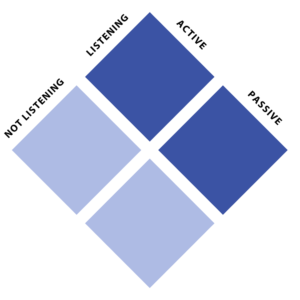
There are few things scarier than being at the front of the room and completely losing control. When you think you’ve lost your audience, knowing what to do to get them back on board is key. How can you get your audience back on your side where other speakers fail?
To be an impactful speaker, you must know your audience. Likewise, to be able to effectively re-engage your audience when you’re not getting the response you expected, you need to be able to read them and know what to look out for. Are they listening, or are they checked out? Are they calling out from their seats because they disagree with you, or because they want to learn more? Are people walking out because they need to go to the bathroom, or because they want to escape what’s being said?
The narrative you spin in your mind determines your confidence, your speaking style and the topics you choose to focus on. The trick isn’t to always be on the lookout for behaviours and prepared to assume the worst, but rather to be prepared for any situation so that you can respond with flexibility and power.
The Matrix of Audience Dissent
The “Diamond of Dissent” comprises a 2×2 matrix reflecting types of negative audience responses, relating to whether they are LISTENING or NOT LISTENING and if they are doing so ACTIVELY or PASSIVELY.
- LISTENING denotes attention: their behaviour is in direct response to what you are saying and/or what they are interpreting. They are engaged, but not in a productive way.
- NOT LISTENING denotes avoidance: their behaviour reflects a lack of engagement with what you are saying. Depending on what’s going on, it may be deliberate or unintentional.
- ACTIVE denotes agency: their behaviour is the result of what they are choosing to do. There is initiative involved.
- PASSIVE denotes complacency: their behaviour is a pattern that they have fallen into and either struggle to or do not attempt to get out of. It is likely to be largely situational or circumstantial.
Beyond one-to-one work with clients looking to perfect keynote speeches and observations of how stand-up comedians win over (or lose) their audiences, the inspiration for this framework came from an unlikely source: the dog whisperer Cesar Millan, who discussed, in a press interview, the varying ways in which dogs respond to owners’ weak “pack leadership”. In the context of human audiences, you can see analogous reactions when the people you address deal with doubt, disagreement and scepticism, or simply distraction, concern and inattention.

Here are the four key negative behaviours to notice and what to say to address them, starting with the most common (and least confrontational) and concluding with the least common (and most confrontational).
Think about people sitting back in their chairs and looking completely blank. Their attention isn’t directed at you or… anything, really. Maybe they’re struggling to stay awake. Perhaps they’re daydreaming. Potentially, they’re just lost in their own thoughts. A resigning audience member is someone who is not listening to you, yet it might not even be deliberate – they’re just mentally not in the room. By far, this type of behaviour is the most common form of “audience dissent” that you will have to tackle as a speaker.
What does “resigning” look like?
- People who seem like they’re blankly staring into the distance.
- Someone who looks like they are having trouble staying awake.
- A person who doesn’t appear to be responding to anything that’s being said.
Generally, resigning behaviour emerges through mental distraction or absent-mindedness. Unlike “retreating” which involves a degree of personal volition, resigning can sometimes just be something we fall victim to when we zone out of a discussion.
What should you do to re-engage “resigning” audience members?
- Reinvigorate the energy of the room. If it seems to be dropping, get people to stand up and stretch, or do some other activity that breaks sleepy stillness.
- Give people “permission” to walk around or do what they have to do to remain attentive. If people feel like they are forced to remain in their seats, they have little recourse. Sometimes, letting people stand at the back of the room makes a big difference.
- Consider how you can integrate activities into your sessions. If you’re going to be speaking for a long time, think about conversational exercises that will have people perk up and engage. Not only do people like getting to do things, but activities also break otherwise continues patterns of zoning out.
Broadly, the way to re-engage resigning audience members is to get them to move around more and to interrupt your monologue with engaging activities. The good news about resigning behaviour is that it is not negatively directed towards you; the bad news is that while people are caught in this cycle, you risk them leaving the room remembering little of what you’ve said.
That person seems to be going in and out of the room a lot. Is it just you, or do they seem to be looking for other things to direct their attention to? A retreating audience member is someone who is not listening to you and appears to be taking active measures to take themselves away from the presentation.
What does “retreating” look like?
- People who seems to be spending more time on their phones than looking up.
- Someone who seem to be going in-and-out of the room frequently.
- A person who is gathering up all their stuff and walking out of the room.
Generally, retreating involves a significant amount of personal agency; their inattention towards you is deliberate. It may be due to what you’re saying or it may be because they’re preoccupied with something else. In either situation, retreating behaviour suggests that what you’re saying isn’t engaging them enough to top whichever other priorities they might be thinking about right now.
What should you do to re-engage “retreating” audience members?
- Request – either at the start or during the session – that people turn off their phones or otherwise limit distractions so that they can best “keep their attention in the room”.
- If a significant number of people are walking around, acknowledge the current busy-ness of the room, and request that people either remain seated or stand up if it helps them focus – giving people options is positive.
- If you perceive that your content is not necessarily landing effectively, ask the audience, “what is the most valuable thing I could share or talk about right now?” Proactively aligning yourself with their priorities is a sure-fire way to get otherwise distracted audience members to refocus themselves.
Broadly, the way to re-engage a retreating audience members is to have them limit possible distractions and/or to realign what you’re talking about to what they are currently most interested in. The degree of directness that you utilise to intervene in retreating significantly depends on your relationship with your audience and the type of session you’re running. Ensure that you are sensitive to the room and responsive to your audience, and this will go a long way in building trust and bringing attention back to the front of the room.
Picture somebody sitting there with their arms folded, frowning, and maybe even shaking their head. Have you ever found yourself speaking to someone who seems to be finding one reason after another to disagree with what you’re saying? That’s the definition of a “repelling” audience member: they’re paying attention to you, yet they continuously aren’t on the same page as you. While they won’t speak up like a “rebelling” audience member, you equally do not have any ability to influence them in this state of mind.
What does “repelling” look like?
- People sitting with arms cross and brows furrowed – closed body language.
- Someone visibly reacting (e.g. sighing, shaking their head) in response what you’re saying
- A person who appears to grow increasingly frustrated as the presentation goes on.
Generally, repelling involves a significant degree of overtly negative body language. Unlike “Actively Listening” disagreement, however, this negativity is more likely to be contained rather than overtly directed towards the speaker. They are more likely to complain to friends afterwards than to start a fight with you.
What should you do to re-engage “repelling” audience members?
- Acknowledge where people might disagree. If you are speaking on a topic that people have previously reacted to before, state something along the lines of “some people might disagree with this, yet they usually change their minds by the time I’m done”. People are more likely to give you the benefit of the doubt when you address potential scepticism or disagreement.
- Check in. Ask if people have any ‘yeah, buts’, ‘how abouts’ or ‘what ifs’ to give people who disagree the opportunity to be heard and have their concerns dealt with.
- Offer people the chance to talk afterwards. By demonstrating your openness to dialogue, you increase your trustworthiness and credibility.
Broadly, the way to re-engage repelling audience members is to acknowledge where you may have lost them and to let them know that you will either address their concerns during the rest of your presentation or are open to further discussion down the line.
When we’re concerned about the audience disagreeing with us, what we imagine usually takes the form of people rebelling. Imagine a heckler; someone verbally challenging you because they disagree with what you have to say. A rebelling audience member is one who listening to what you have to say, and actively disagreeing with it. Among the categories in the Diamond of Dissent, this is the behaviour that is least likely to occur and unlikely to be exhibited by more than a one person within one group.
What does “rebelling” look like?
- People calling out from their seats unprompted.
- Someone challenging specific things that you have said.
- A person appearing to start a debate with you.
Generally, rebelling involves a significant degree of active conflict and verbal disagreement which may be motivated by what you have said, how you have said it, or who you are.
What should you do to re-engage “rebelling” audience members?
- If there is a specific disagreement, ask what the specific disagreement is and promise to address it. Resolving disagreement in this way boosts your authority and is likely to leave the individual feeling responsibly addressed rather than “shot down”.
- If you are being heckled (e.g. “your speech sucks”), ask for feedback from the room. When the majority speak out in your favour, it marginalises the credibility of the person speaking out, and allows you to justly ask them to sit down or leave.
- If someone is attempting to start a debate or a conversation with you, suggest that they speak to you afterwards. Advising them in this way demonstrates your openness to dialogue and prevents your session from being hijacked by another person.
Broadly, the way to re-engage rebelling audience members is to acknowledge what they have to say and to offer a means for it to be addressed in a way that does not disrupt the timeframe you have determined for your presentation.
The purpose of the Diamond of Dissent is to elucidate the most common traps that speakers fall into that has their words not land with as much impact as they deserve. Rather than hold this matrix in mind explicitly, use it as a basis to hone your ability to recognise where people are disengaging and as a foundation to think on your feet and say the right things at the right time.
When somebody wants to argue with you, don’t let their voice take over the room. When people seem to be sitting in their seats unconvinced, address their guardedness rather than ignore it. When people seem to be “running away” from your presentation, focus on delivering value that will make them compelled to stay. When people seem to be zoning out in their seats, reinvigorate the room and bring energy back to your session.
The more flexible you are a speaker, the more power you have to influence the room. If you make your #1 goal to be responsive to your audience, you will already be a notch above so many speakers out there who try to make it about themselves.
- Resigning: When people seem to be zoning out in their seats, reinvigorate the room and bring energy back to your session.
- Retreating: When people seem to be “running away” from your presentation, focus on delivering value that will make them compelled to stay.
- Repelling: When people seem to be sitting in their seats unconvinced, address their guardedness rather than ignore it.
- Rebelling: When somebody wants to argue with you, don’t let their voice take over the room.
What next step can you take in your development as a speaker to become more responsive to your audience? The less it becomes about you and the more it becomes about them, the more of an impact you will have every time you take the stage.
Want to learn about how to speak confidently and be remembered for the right reasons, how to take the stress out of practicing public speaking, or how to give superb feedback? Click here to return to My Portfolio and keep learning.
